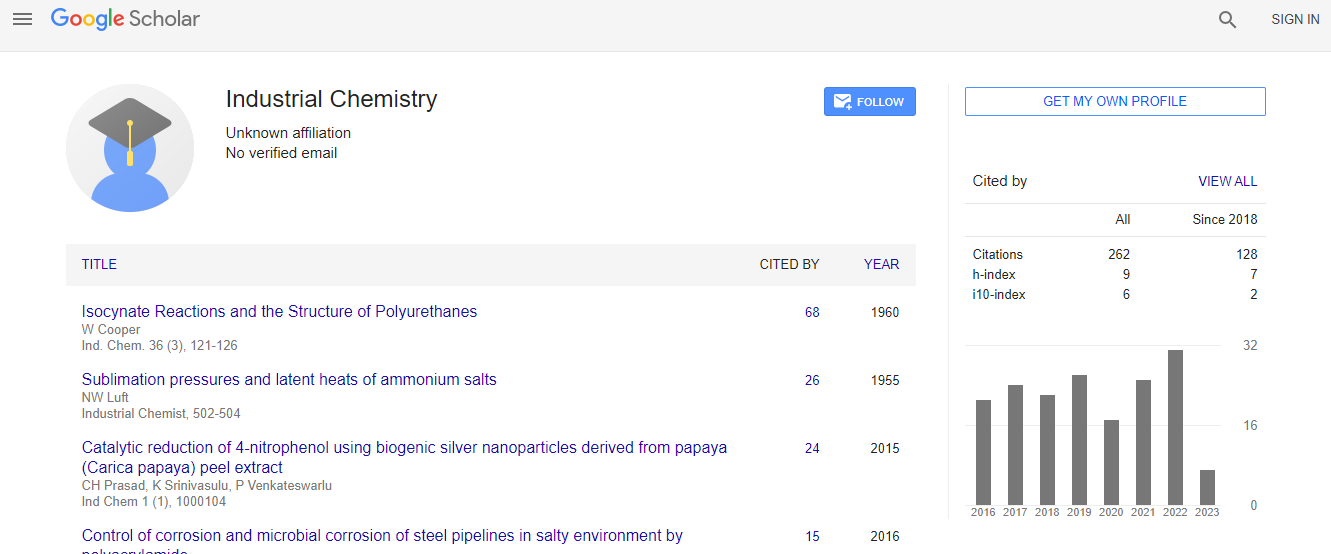Our Group organises 3000+ Global Conferenceseries Events every year across USA, Europe & Asia with support from 1000 more scientific Societies and Publishes 700+ Open Access Journals which contains over 50000 eminent personalities, reputed scientists as editorial board members.
Open Access Journals gaining more Readers and Citations
700 Journals and 15,000,000 Readers Each Journal is getting 25,000+ Readers
Google Scholar citation report
Citations : 262
Industrial Chemistry received 262 citations as per Google Scholar report
Indexed In
- Index Copernicus
- Google Scholar
- RefSeek
- Directory of Research Journal Indexing (DRJI)
- Hamdard University
- EBSCO A-Z
- OCLC- WorldCat
- Scholarsteer
- Geneva Foundation for Medical Education and Research
- Euro Pub
Useful Links
Recommended Journals
Related Subjects
Share This Page
Nano-TiO2 photo catalysts: Doping, morphology control and immobilization
International Conference on Industrial Chemistry
Jian-Wen Shi and Chunming Niu
Xi��?an Jiaotong University, China
ScientificTracks Abstracts: Ind Chem
Abstract
Modulation of polyhedral morphology toward highly active facets has attracted great interest in the recent years, and it has been considered as an effective approach to improve the catalytic activity of materials. It is widely believed that {001} facets of anatase TiO2 crystals can provide more active sites for photocatalytic oxidation reaction, which significantly promotes its photocatalytic activity. For utilizing solar light, visible light responsive TiO2 crystals with high reactive {0 0 1} facets are highly desired. In our recent work, we prepared N-doped anatase TiO2 plates (NTP) with dominated {001} facets, and showed that samples are visible-light photocatalytic active for methylene blue (MB) decomposition. However, its activity was low due to the high recombination rate of the photogenerated electron-hole pairs. To improve the performance, in this work, NTP modified by CdS quantum dots was successfully prepared by using thiolactic acid as a linker for the first time, and the obtained samples were characterized by SEM, TEM, EDX, FTIR, XRD and DRS, and their photocatalytic activities for the degradation of methylene blue, phenol and 2,4,6-trichlorophenol were evaluated under visible light irradiation. The results show that this NTP/CdS system has much better photocatalytic activity for the degradation of organic pollutants. The photocatalytic activity improvement can be attributed to the enhancement of visible light absorption and the reduction of electron-hole pair recombination rate, which is resulted from N-doping, preferred crystallographic orientation and the strong interaction between NTP and highly dispersed CdS QDs.Biography
Jian-Wen Shi received his PhD degree from the China University of Petroleum in 2007. He worked in the Institute of Urban Environment (IUE), Chinese Academy of Sciences (CAS) as an Assistant Reseacher and Associate Researcher, successively (2007.7–2013.12). During this period, he worked at Prof. Lianzhou Wang’s laboratory for one years in the University of Queensland, Australia (20010.5–2011.5). Currently, he is a Associate Professor in Xi’an Jiaotong University. He mainly focuses on the development of nanomaterials for catalytic applications, such as photocatalysis, selective catalytic reduction of NOx, etc.
Email: shijnwn@163.com

 Spanish
Spanish  Chinese
Chinese  Russian
Russian  German
German  French
French  Japanese
Japanese  Portuguese
Portuguese  Hindi
Hindi 